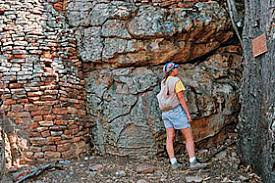
THE seemingly overlooked Nambya’s vast cultural heritage that includes dry stone walls and a rich historical narrative is under the spotlight in a new archaeological research book that calls for reassessment of an important aspect and attribute of Zimbabwe culture.
The book, titled The Past in The Present: The Zimbabwe Culture and Other Archaeological Heritage in North-Western Zimbabwe, is a result of archaeological research conducted by academics, Plan Shenjere-Nyabezi and Gilbert Pwiti.
Zimbabwe culture is a cultural tradition that was named after the site of Great Zimbabwe and represents a major civilisation in southern Africa between the 11th and 18th centuries Anno Domini (AD).
The most important attribute of Zimbabwe culture is the stone architecture, which comprises free-standing dry-stone walls.
The research, which makes up the book based on archaeology, ethnoarchaeology, ethnohistory and cultural heritage management, was conducted at major sites of Bambusi, Matowa and Shangano in Hwange, Matabeleland North province.
Despite being considered the least researched and archaeologically known part of the country, the north-western Zimbabwe boasts age-old civilisation that flourished at the same time with other major civilisations such as Khami and Mutapa States.
“While the existence of the pre-colonial Nambya State of north-western Zimbabwe has been known since early colonial times, the State has not received much archaeological attention, in comparison to other precolonial State systems in Zimbabwe and southern Africa,” part of the book reads.
According to the book, most knowledge of the Nambya State has been based on oral tradition and some ethnographic records produced by early European travellers and observers.
- Whose responsibility is preservation of cultural heritage?
- Nambya cultural heritage under spotlight in new book
- Nambya heritage under the spotlight
- Great Zimbabwe US$475K restoration, preservation kitty commissioned
Keep Reading
“The Nambya State shows a similar degree of size and complexity, compared to the other more popularised precolonial State systems of southern Africa such as the Zimbabwe State with its capital at Great Zimbabwe, the Torwa State with its capital at Khami and Mutapa State with its capitals at Mutota, Kasekete and Chiwawa in Northern Zimbabwe,” the book further states.
“In this regard, the archaeological dating evidence has, in fact, shown that the Nambya State was developing and flourishing during the same period as the more popularised Mutapa State and the Rozvi State with its capitals such as Naletale and Danangombe in central Zimbabwe.”
The research also shot down the colonial view that classified stone wall styles and chronology.
An architect Anthony Whitty defined four wall styles which are P style (earliest), PQ style (intermediate), Q style (the finest) and R style (more recent and degenerate).
Whitty’s wall styles classification that they were reflective of progressive time phases related to construction techniques and their improvement was questioned in the research.
“There is an observable occurrence of the different wall styles in combination within the same sites and between the sites. This is to the extent that assigning sites to a specific phase associated with progressive time period becomes problematic. At the site of Shangano, for example, all the styles are seen within and between the different enclosures,” the book noted.
The book also highlights the need for a shift from the Eurocentric heritage management process to a community-based management that respects the native’s cultural practice and spirituality.
“For a long time, archaeologists, heritage managers and heritage institutions have been engaged in debates and discussions on issues of community participation in archaeological research, inclusiveness, development and beneficiation of local communities from their heritage.
“... National Museums and Monuments of Zimbabwe should work with traditional leaders and incorporate these traditional management structures and involve the local communities in the management of the heritage sources.
“This is considered against the background of the new thinking in heritage management in many developing countries such as Zimbabwe that archaeological heritage places have meaning and significance to local communities, and should not be managed using only modern scientific methods and approaches.”
The book further notes: “The new thinking is that a holistic management system and approach should, therefore, include the views, values and perceptions of the communities, including recognition of the spiritual values and the accompanying traditional community-based systems of heritage management.”
It is alleged that the Nambya State developed as a splinter group from the Zimbabwe State, whose capital was Great Zimbabwe.
According to the research, the reason for the split from Great Zimbabwe and the Zimbabwe State and the subsequent long journey westwards was that one of the Mambo’s sons, Dende, who is also known as Dendelende, Cholobamago or Sawanga in some narratives, decided to rebel against his father’s rule to set up his own kingdom in the 18th century.
It is also alleged that the founder of the Nambya State, Whange Chilobamago, was buried inside Shangano site.






